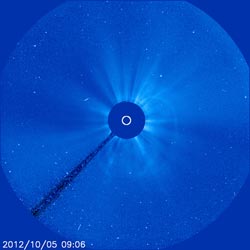Sun Spits Out A Coronal Mass Ejection

The Solar and Heliospheric Observatory (SOHO) captured this image of the sun at 5:06 a.m. EDT on Oct 5, 2012 showing a coronal mass ejection (CME) spreading away from the sun toward Earth. Credit: SOHO (ESA & NASA) <br>
Not to be confused with a solar flare, which is a burst of light and radiation, CMEs are a phenomenon that can send solar particles into space and can reach Earth one to three days later.
Experimental NASA research models show the CME to be traveling at about 400 miles per second.
When Earth-directed, CMEs can affect electronic systems in satellites and on Earth. CMEs of this speed, however, have not generally caused major effects in the past. Further updates will be provided if needed.
NOAA's Space Weather Prediction Center (http://swpc.noaa.gov) is the United States Government official source for space weather forecasts.
What is a CME?
For answers to this and other space weather questions, please visit the Spaceweather Frequently Asked Questions page.
Karen C. Fox
NASA Goddard Space Flight Center, Greenbelt, MD
Media Contact
More Information:
http://www.nasa.gov/mission_pages/sunearth/news/News100512-cme.htmlAll latest news from the category: Earth Sciences
Earth Sciences (also referred to as Geosciences), which deals with basic issues surrounding our planet, plays a vital role in the area of energy and raw materials supply.
Earth Sciences comprises subjects such as geology, geography, geological informatics, paleontology, mineralogy, petrography, crystallography, geophysics, geodesy, glaciology, cartography, photogrammetry, meteorology and seismology, early-warning systems, earthquake research and polar research.
Newest articles

High-energy-density aqueous battery based on halogen multi-electron transfer
Traditional non-aqueous lithium-ion batteries have a high energy density, but their safety is compromised due to the flammable organic electrolytes they utilize. Aqueous batteries use water as the solvent for…

First-ever combined heart pump and pig kidney transplant
…gives new hope to patient with terminal illness. Surgeons at NYU Langone Health performed the first-ever combined mechanical heart pump and gene-edited pig kidney transplant surgery in a 54-year-old woman…

Biophysics: Testing how well biomarkers work
LMU researchers have developed a method to determine how reliably target proteins can be labeled using super-resolution fluorescence microscopy. Modern microscopy techniques make it possible to examine the inner workings…





















